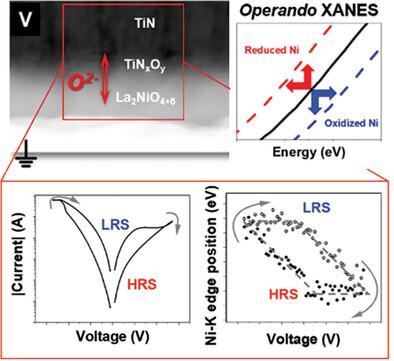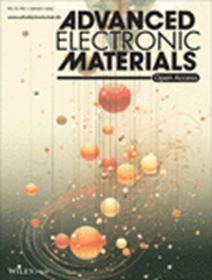对基于 La2NiO4+δ 的膜电容器件中价态变化机制的运算光谱学研究
IF 5.3
2区 材料科学
Q2 MATERIALS SCIENCE, MULTIDISCIPLINARY
引用次数: 0
摘要
基于氧化还原反应和氧动力学的价变存储器件被认为是下一代非易失性存储器件和神经形态架构最有前途的候选器件之一。基于 La2NiO4+δ 的器件已经展示了模拟电阻开关行为,但其基本机制尚未完全明了。要深入了解器件的行为,采用元素选择技术提供氧迁移的直接信息至关重要。在这项工作中,使用了一种独创的操作性 X 射线吸收近边缘光谱(XANES)方法对 TiN/La2NiO4+δ/Pt 器件进行了研究,该方法基于监测固定能量位置的吸收强度变化,结合原位电子能量损失光谱(EELS)测量,为了解电阻开关机制提供了宝贵的信息。这种方法可以研究 TiN/La2NiO4+δ 界面 TiNxOy 夹层的形成,并直接监测 TiNxOy 和 La2NiO4+δ 之间的氧迁移。在器件运行过程中,当器件在两个电压极性中循环时,始终能测量到 Ni K 边光谱的能量移动,从而证实了价态变化机制在这些器件的电阻开关行为中的关键作用。此外,还提出了一种基于丝状开关和界面开关共存的开关模型。本文章由计算机程序翻译,如有差异,请以英文原文为准。

Operando Spectroscopic Investigation of the Valence Change Mechanism in La2NiO4+δ ‐Based Memristive Devices
Valence change memory devices, based on redox reactions and oxygen dynamics, are considered to be one of the most promising candidates for the next generation of non‐volatile memory devices and neuromorphic architectures. Devices based on La2 NiO4+δ have demonstrated analog resistive switching behavior, but the underlying mechanism is not fully understood. To get a profound understanding of the device's behavior, the employment of element‐selective techniques to provide direct information on oxygen migration is of paramount importance. In this work, TiN/La2 NiO4+δ /Pt devices are studied using an original operando X‐ray absorption near edge spectroscopy (XANES) methodology based on monitoring absorbance intensity changes at a fixed energy position which, in combination with in situ electron energy‐loss spectroscopy (EELS) measurements, has provided valuable insights into the resistive switching mechanism. This approach allows to study the formation of the TiNx Oy interlayer at the TiN/La2 NiO4+δ interface and directly monitor oxygen migration between TiNx Oy and La2 NiO4+δ . An energy shift of the Ni K‐edge spectra is consistently measured during the device operation as it underwent cycling in both voltage polarities, thus confirming the pivotal role of the valence change mechanism in the resistive switching behavior of these devices. Furthermore, a switching model based on the coexistence of filamentary and interfacial switching is proposed.
求助全文
通过发布文献求助,成功后即可免费获取论文全文。
去求助
来源期刊

Advanced Electronic Materials
NANOSCIENCE & NANOTECHNOLOGYMATERIALS SCIE-MATERIALS SCIENCE, MULTIDISCIPLINARY
CiteScore
11.00
自引率
3.20%
发文量
433
期刊介绍:
Advanced Electronic Materials is an interdisciplinary forum for peer-reviewed, high-quality, high-impact research in the fields of materials science, physics, and engineering of electronic and magnetic materials. It includes research on physics and physical properties of electronic and magnetic materials, spintronics, electronics, device physics and engineering, micro- and nano-electromechanical systems, and organic electronics, in addition to fundamental research.
 求助内容:
求助内容: 应助结果提醒方式:
应助结果提醒方式:


